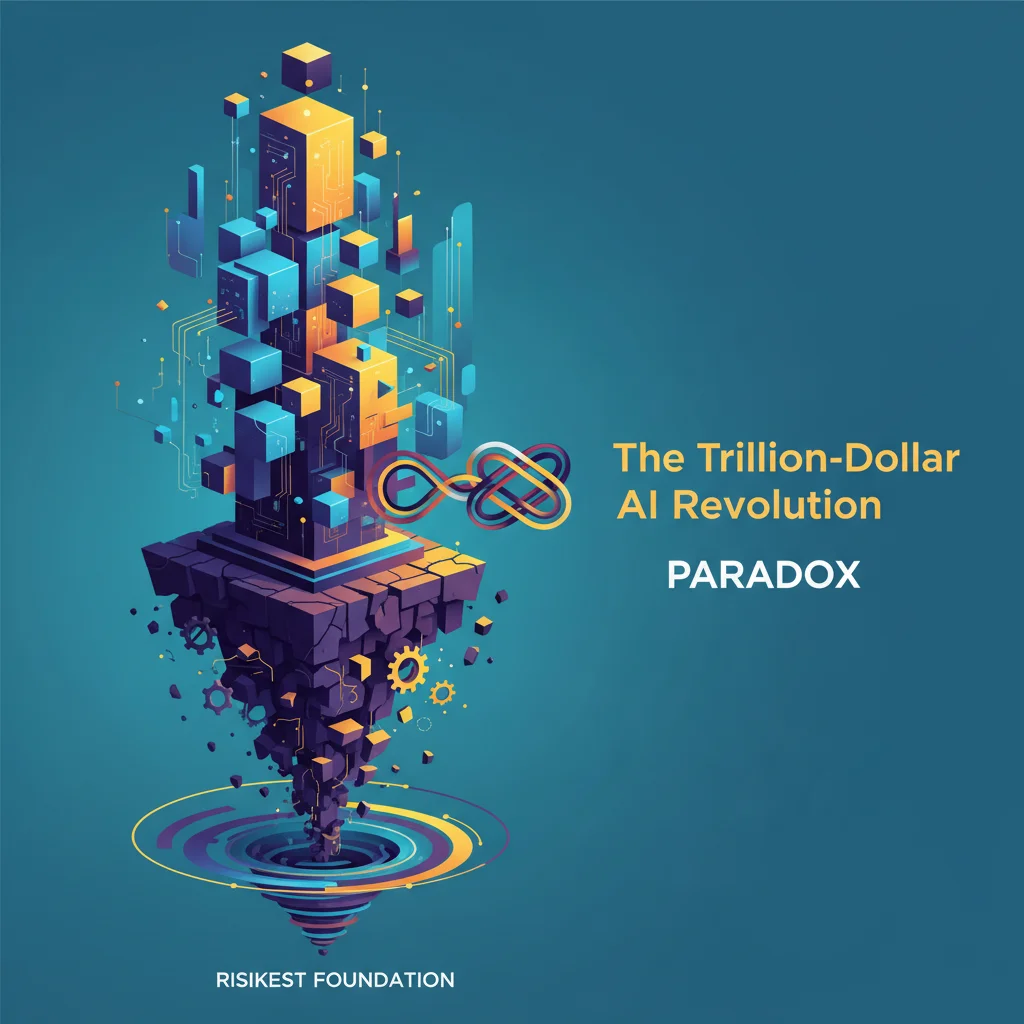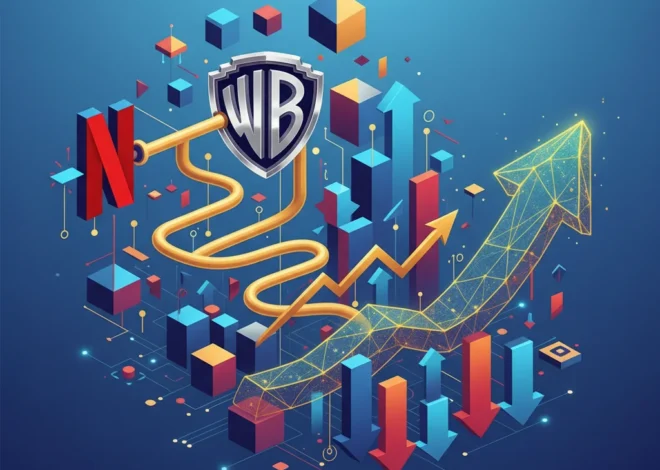
The Trillion-Dollar Paradox: Why the AI Revolution is Built on the World’s Riskiest Foundation
In the world of technology, we celebrate the wizards of software. We talk endlessly about the brilliance of large language models, the elegance of cloud-native architecture, and the disruptive power of SaaS startups. From the generative AI that creates stunning images to the complex machine learning algorithms that power our financial markets, the focus is almost always on the code. But what if I told you that this entire digital universe, this explosion of artificial intelligence and software innovation, rests precariously on the shoulders of a single company located on a tiny island?
That company is the Taiwan Semiconductor Manufacturing Company, or TSMC. And right now, it’s at the center of a massive financial paradox. While its stock has been on a meteoric rise, fueled by an insatiable global demand, it operates under a constant geopolitical shadow that could, in a worst-case scenario, bring the tech world to a screeching halt. The story of TSMC’s recent market rally isn’t just about numbers on a screen; it’s a high-stakes drama about the triumph of desperate need over paralyzing fear. And for anyone in tech—from developers and entrepreneurs to investors and executives—understanding this tension is no longer optional. It’s essential.
The Undisputed King: Why Everyone Needs TSMC
First, let’s get one thing straight: calling TSMC “important” is a colossal understatement. TSMC is the world’s premier “pure-play” semiconductor foundry. This means they don’t design their own chips like Intel or Nvidia. Instead, they operate the most advanced manufacturing plants (called “fabs”) on the planet, and they build chips for everyone else.
Think of it this way: Apple, Nvidia, AMD, and Qualcomm are like Michelin-starred chefs who create groundbreaking recipes. But TSMC owns the only kitchen in the world with the futuristic ovens and unparalleled expertise to actually cook those recipes to perfection. Without their kitchen, those revolutionary designs remain just blueprints.
This dominance is most pronounced at the cutting edge. The most powerful chips today—the ones that power everything from the iPhone in your pocket to the massive Nvidia H100 GPUs training the next generation of AI—are built on 3-nanometer (nm) and 5-nanometer process nodes. This incredibly complex technology allows for billions of transistors to be packed onto a tiny sliver of silicon, delivering the raw performance necessary for modern computing. And who controls the vast majority of this advanced manufacturing capacity? You guessed it. TSMC is responsible for over 90% of the world’s most advanced logic chips (source).
This manufacturing monopoly is the engine behind the current artificial intelligence boom. The complex neural networks involved in machine learning require a level of parallel processing power that was unimaginable a decade ago. Every startup building an AI-powered SaaS platform, every enterprise deploying automation, and every developer writing programming code that leverages a cloud API is an indirect customer of TSMC. Their work, their innovation, and their company’s valuation are all downstream from a TSMC fab.
The Elephant in the Room: The Geopolitical Tightrope
If TSMC is so critical, why is there any “fear” involved? The answer lies in geography. TSMC’s most advanced fabs are located in Taiwan, an island that has become the focal point of geopolitical tension between the United States and China. This creates a concentration risk of epic proportions. The very heart of the global digital economy beats within a few hundred square miles of a potential conflict zone.
Investors and tech leaders are forced to grapple with a terrifying “what if” scenario. A conflict, a blockade, or even a major escalation in tensions could instantly sever the world’s supply of advanced chips. The ripple effects would be catastrophic, impacting everything from consumer electronics and automotive manufacturing to national defense and, of course, the entire cloud computing and AI industry. This isn’t just a supply chain issue; it’s a potential single point of failure for the modern world.
This risk extends into the digital realm as well. The immense strategic importance of semiconductor manufacturing makes it a prime target for state-sponsored cybersecurity threats, from intellectual property theft to sabotage. The fear, then, is not just about physical conflict but about the fragility of a hyper-concentrated, high-value asset in a turbulent world.
The Great Balancing Act: Need vs. Fear
So, we have two powerful, opposing forces. On one side, the desperate, insatiable “need” for TSMC’s chips to power the AI revolution. On the other, the profound “fear” of the geopolitical risks tied to its location. For years, investors have tried to price this risk, often putting a discount on TSMC’s valuation compared to other tech giants. But recently, the scales have tipped dramatically.
TSMC’s stock has surged, adding hundreds of billions in market value. This rally signals that, for now, the market believes the need for its technology is so overwhelming that it eclipses the risk. As the Financial Times aptly puts it, this is a “triumph of need over fear” (source). The logic is simple: the demand for AI is not a hypothetical future trend; it’s a tidal wave happening right now, and TSMC is the only one with a surfboard big enough to ride it.
To better understand this tug-of-war, let’s break down the core arguments for the bull case (Need) and the bear case (Fear).
| The Bull Case: The Unstoppable Power of “Need” | The Bear Case: The Long Shadow of “Fear” |
|---|---|
| Unrivaled Technological Lead: Decades ahead of competitors in advanced node manufacturing (3nm, 2nm). | Extreme Geographic Concentration: The majority of advanced manufacturing is in a single, politically sensitive location. |
| Indispensable to AI Giants: The sole manufacturer for critical AI hardware from companies like Nvidia, Apple, and AMD. | Supply Chain Catastrophe Risk: Potential for massive global disruption from conflict, blockade, or natural disaster. |
| Insatiable Global Demand: The AI, cloud, and high-performance computing revolutions are creating exponential demand. | Global De-Risking Efforts: The US CHIPS Act and similar EU/Japan initiatives aim to build alternative supply chains. |
| Massive Barriers to Entry: Replicating TSMC’s capital-intensive ecosystem and expertise would take over a decade and cost trillions. | Cybersecurity and Espionage: High-value target for state-sponsored attacks aimed at stealing IP or causing disruption. |
This table illustrates the core dilemma. While the risks are severe and existential, the demand is immediate, tangible, and growing at a staggering rate. The market is betting that the world simply cannot afford for the “Fear” scenario to materialize, because the “Need” is too great.
The real story here is that for the next 5-7 years, the AI boom is almost entirely dependent on stability in the Taiwan Strait. This creates a strange paradox for startups and innovators. You’re encouraged to build the next great AI company, but the core resource you depend on—advanced silicon—has a geopolitical risk profile unlike any other commodity in history. It forces a strategic question: should we focus not just on building more powerful models, but also on creating more efficient software and algorithms that can do more with less? The future of software innovation might not just be about bigger models, but smarter, more resilient ones that acknowledge the fragility of their physical foundation.
What This Means for Tech Professionals, Founders, and Developers
This isn’t just a story for Wall Street. The TSMC paradox has real-world implications for everyone in the tech ecosystem.
- For Developers & Programmers: The cost and availability of the cloud computing resources you use every day are directly linked to TSMC. Any disruption would inevitably lead to skyrocketing prices for GPU instances and compute time. This dynamic could push the industry towards more efficient coding practices and a renewed focus on software optimization, as brute-force computing becomes a less viable strategy.
- For Entrepreneurs & Startups: If you’re founding a company, especially in the AI space, you are implicitly making a bet on TSMC’s continued, uninterrupted operation. The valuation of your AI-powered SaaS company is tied to this geopolitical reality. Building a resilient business model means thinking about this dependency. Could your service operate on less powerful, more widely available hardware if necessary? How will you manage costs if compute prices double overnight?
- For Tech Professionals & Leaders: Understanding the semiconductor supply chain is now a core competency. The future of innovation, from self-driving cars to personalized medicine, depends on it. Strategic decisions about building data centers, choosing cloud providers, and investing in R&D must now include a geopolitical risk assessment that starts in Hsinchu, Taiwan. A recent report highlighting a 25% year-over-year revenue jump for TSMC shows just how concentrated this demand is becoming (source).
The Bet We’re All Making
The triumph of need over fear in TSMC’s stock chart is a reflection of a collective bet being made by the entire world. We are betting that the global economy is now so intertwined and so dependent on this single company that all actors have a vested interest in its stability. We are betting that the promise of an AI-driven future is too lucrative to let geopolitics get in the way.
It’s a bold, high-stakes wager. For now, the momentum is undeniable. The demand for the powerful, efficient chips that TSMC produces is the primary force shaping the market and driving the next wave of technological evolution. But as we build our innovative software, our automated systems, and our intelligent cloud platforms, it’s crucial to remember the fragile, concentrated foundation upon which it all stands. The future is being forged in silicon, and one company holds the hammer.


